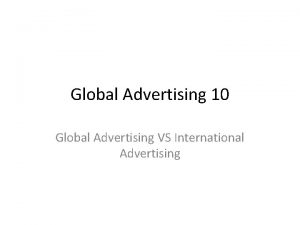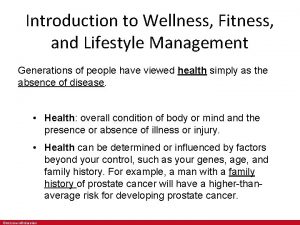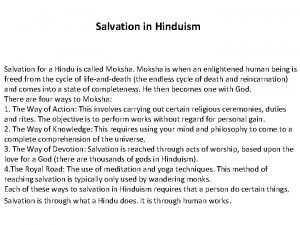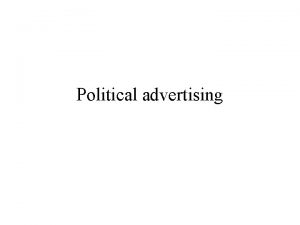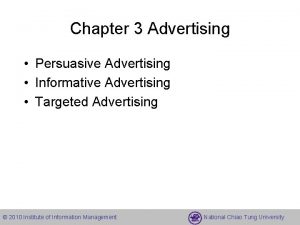POLITICAL ADVERTISING Chapter 6 Reaching the Apolitical Advertising











- Slides: 11

POLITICAL ADVERTISING Chapter 6

Reaching the Apolitical � � � Advertising allows candidates to reach uninterested and unmotivated citizens TV ads reach people, for example, who happen to be watching a preferred TV program While some or many people may be apolitical and not really interested in various campaigns, research shows that they are often profoundly affected by the political advertisements to which they are exposed

“Decoding” Political Ads � � � Our book’s author contends that political advertising is the most important genre of advertising This because our decisions about who we vote for play a crucial role in determining what laws will be passed and how we will lead our lives He offers insights into the methods used by political advertisers, thus helping us make more informed and more intelligent decisions when we vote

Four kinds of political ads From social scientist Montague Kern � � Name Identification Spots- shown early in the campaign Argument Spots- present candidate positions on issues Attack Spots- focus on the opponent Positive Visionary Appeals- used at the end of a campaign to give voters a reason to vote for the candidate

Stages and Kinds of Ads in Political Campaigns Time in Campaign Early Later Still End of Campaign Kind of Ad Function Name ID Ads Identity Argument Ads Ideology Attack Ads Insult Positive Visionary Ads Image

Haley-Sheehen S. C. Gov. Race Examples of Four Kinds of Political Ads NIKKY HALEY Name Identification“Better” Ad Arguments/Positions“Possible” Ad “Vision” Ad “Movement” Ad Attack/Negatives “Own backyard” Ad “Mirror” Ad “Plan” Ad Positive Visionary Appeals. Pending… Also, Jenny Sanford Endorses Haley VINCENT SHEEHEN Name Identification- “Find Out” Ad Arguments/Positions“Moving” Ad “Crossroads” Ad Attack/Negatives- “Says” Ad “Thinks” Ad Positive Visionary Appeals. Pending…

Haley and Sheehen HALEY HOMEPAGE “Latest Attack on Haley” (May SHEEHEN HOMEPAGE 2010) Haley called a “raghead” (June 2010) Haley Rocky Job Departure (Oct. 2010) http: //www. postandcourier. c om/news/2010/oct/13/newpolling-gives-haley-9 -pointlead/Haley Leads by Nine Points (Oct. 2010) Blogger Details Tryst (Oct. 2010) Sheehen Ads Link Haley, Sanford (Sept. 2010) Sheehen/Haley Launch Attack Ads (Sept. 2010) State Paid Thousands to Sheehen Law Firm (Oct. 2010)

Back to the Book… The 1998 California Primary Case Study (p. 103 -106) Relationship between political advertising and voting � Are people no longer affected by negative campaigns? In polls, people will say they don’t like negative campaigns but voting records seem to indicate that they are affected for influenced by them � Numerous case studies of elections show that negative campaigns, full of attack commercials, are effective � One theory is that negative campaigns turn off voters who then will not vote, playing into the hands of conservative Republican candidates who rely on the minority of conservative GOP who DO vote- in contrast to the majority of generally liberally Democrats, who don’t vote � � Is it the number or the quality of the advertisements that counts? � � Depends! In California example, Gray Davis’s advertising push came at the end of the campaign after his two higher spending opponents had hurt each other with attack ads earlier in the campaign Is it the advertising or the record of the candidate that is crucial? � Again it depends. In California, Lt. Gov. Davis’ slogan “Experience Money Can’t Buy” worked because he had two wealthy opponents with little or no government experience. Voters seemed to reject the notion that experience in government is bad and less experience a politician has, the better- a position made popular by Ronald Reagan and many other conservative Republicans– including California’s current governor, Arnold Schwarenegger

Use of Symbols � Political ads use symbols, as best they can, that try to generate positive appeals like these: � Hope (for the future) � Compassion (for those in need) � Ambition (to do what’s needed) � Trust � Nostalgia (for the mythic past) � Intimacy � Reassurance � Local Pride � National Pride

We want candiates… � � � Who reassure us Who give us hope Who are compassionate toward the poor and disadvantaged Who make us feel proud about where we live and about America We like to feel our candidates are like us and are aware of people like us Even though they may be quite far removed- in distance and socio-economic status- from us

Symbols to Get Across Messages Directly and Viscerally � � � Use of the American flag Candidate wearing a hard hat, thus identifying with the blue-collar worker) A “visionary” look over the horizon The all-American family All to generate the emotional response that lead to instant and powerful identification with the candidate and hopefully, as a consequence, votes for the candidate Not that language and words aren’t important, but in commercials a great deal of the communication burden is carried by physical symbols
 Chapter 22 reaching out cross-cultural interactions
Chapter 22 reaching out cross-cultural interactions Chapter 22 reaching out cross-cultural interactions
Chapter 22 reaching out cross-cultural interactions Chapter 22 reaching out cross-cultural interactions
Chapter 22 reaching out cross-cultural interactions Global advertising and international advertising
Global advertising and international advertising Reaching for the infinite heart
Reaching for the infinite heart Introduction to wellness fitness and lifestyle management
Introduction to wellness fitness and lifestyle management Strategies for reaching global markets
Strategies for reaching global markets Hinduism method of reaching paradise
Hinduism method of reaching paradise Reaching out from within
Reaching out from within Forgetting those things which are behind nkjv
Forgetting those things which are behind nkjv Reaching beyond yourself
Reaching beyond yourself When i found the joy of reaching your heart
When i found the joy of reaching your heart



